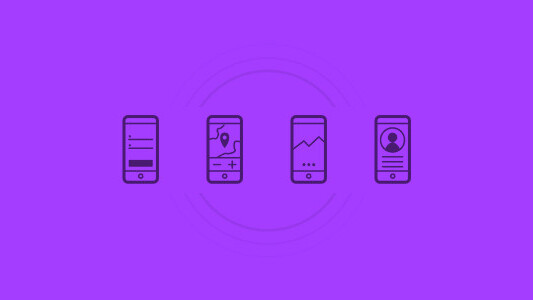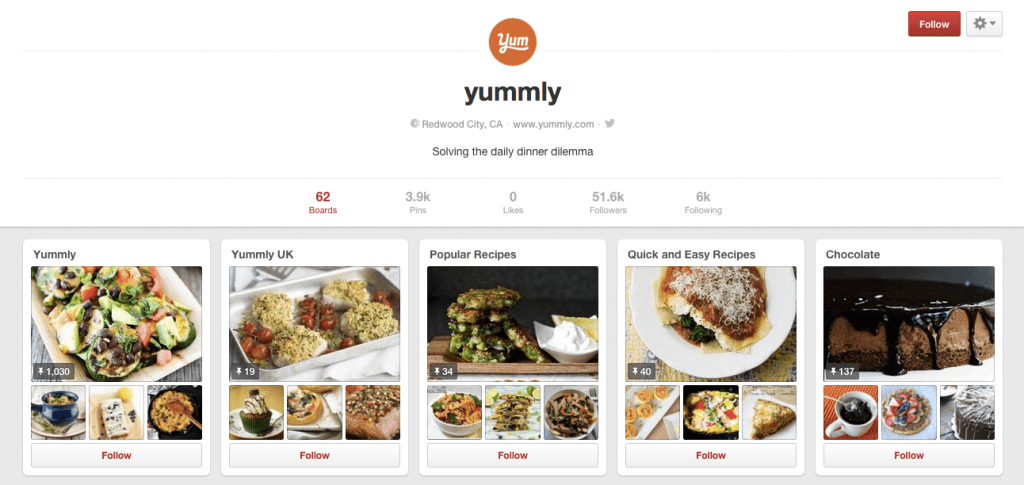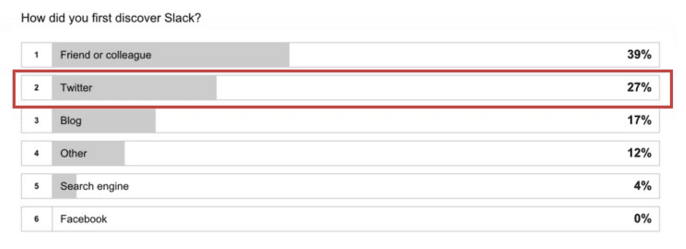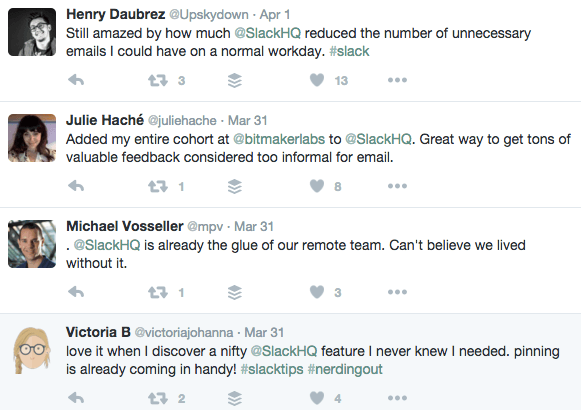
So many factors may have worked for making your app popular. It may have been a great PR campaign, or you hit the right chord with your influencer marketing strategy. The point is that all these viral factors are short-lived. Once the initial buzz dies down, most apps seem to lose their mark with their audience and users.
What keeps people coming back?
A while back, I read an awesome post by Buffer’s Kevan Lee, which listed the apps on the home screens of the biggest marketers in the business. I noticed that a few apps made it to the home screen of almost everyone’s phone.
So here’s the question: what makes a few apps more popular than the rest and how can app marketers build a better audience for themselves?
How can you build a long-term relationship with app users?
The answer to this question may lie in building a community of loyal and devoted users. To do that, you need a platform that’s engaging, fast-paced and commands authority. What better option for that is there than using social media?
Let’s look at the most interesting ways to build a successful community for your mobile app using social media.
- It helps enhance your user’s app experience. The informal platform offers a great way for marketers to bounce ideas, take feedback and better their app. It’s always smart to get feedback from users before their review hits the app store.
- Communities bring a sense of familiarity to the user, increasing the stickiness of your app. An engaged community also builds trust.
- Trust brings more users to your app!
- An engaged community also ensures organic growth. Since communities are driven by word-of-mouth, it helps others discover your app.>
There are several reasons for app marketers to focus on building communities, and a lot of it will depend on how each marketer wants to leverage their own. There are tons of ways to connect.
For now, I’ll share with you all a few quick tips for doing so on social media.
Building a kick-ass app community
Building a kick-ass community using social media doesn’t involve magic. With a little patience and thought, you can hit your goals.
Here’s what you need to keep in mind:
Put effort where it counts
As a marketer, you can take your pick of social media platforms to play with. However, think it through before making that leap. It’s important to stay involved in and devoted to communities, so don’t commit to more than you can handle.
Think about where your users are spending most of their time and that’s where you should spend more of yours.
For example, it makes sense for foodie apps like Yummly to engage more users on Pinterest, instead of something like LinkedIn. Recipe photos will fit in and it’s popular for their users.
And it’s smart for a B2B SaaS community like HootSuite’s to be more vocal on Twitter or LinkedIn.

Talk to your high-value partners
I’ve always believed that users are a high-value partner. To build a great community of users, you need to know what they think about your app. It may be pretty simple to have one-on-one conversations with your app’s first users, but not once your app grows.
With several conversations going on at once, in a few different places, you need to have a process for learning from your users. A simple tool like Mention can help you keep up with any new conversations.
Invest in a dedicated community manager, who can find, engage and connect with your users on social media to help solve their problems and answer their questions.
Buffer, everyone’s favorite social scheduling tool, is a great example of heightened community engagement on all social platforms that they’re active on. This includes Twitter, Facebook, andInstagram, to list a few.
Now, here’s the thing.
Buffer has set up an exceptional benchmark when it comes to interacting with their users and taking it up a notch! Their users really do determine the direction of the products.
They just launched Pablo 2.0 and were obviously flooded with feedback. Not only was the feedback taken and applied, but Buffer also helped users voice their opinions using a dedicated forum. That’s a great example of showing the true value of listening to your community.
Invest in a brand voice
Building a community of loyal users is the best way to increase your app’s reach. But you need to give people a reason to engage in the first place.
App marketers need to create a unique brand voice to attract more users. It’s common for apps with a unique personality to have great brand loyalty. A fine example here is Slack, an app that re-invented the wheel and saw tremendous growth.
Before Slack, users were dependent on tools like HipChat, Yammer, or an assortment of other individual tools. Slack, however, broke this mold and brought cohesion to team communication.
But a big factor behind its growth can be attributed to its unique brand voice. Anna Pickard, the editorial director at Slack, has explained it in-depth in this interview. The same brand voice echoes through its social platforms.
Value word-of-mouth
According to a popular Nielsen study, 84% of users value word-of-mouth from friends and family. That’s proof that investing in a community can’t be sidelined by app marketers.
Recommendations from such communities on Twitter, Facebook or other platforms will push the growth of your app. Hiten Shah recently conducted a survey 731 Slack Users Reveal Why It Is So Addictive that hints at the power of word-of-mouth coming from social platforms. For example, here’s one question:

In this survey, 27 percent of users said that they discovered Slack through Twitter. At the same time, the percentage of people who found Slack through Facebook remained zero. This takes us back to the first point that emphasizes in going where your users do. It may be true that, for Slack, Twitter is a bigger community than Facebook, which is evident through their Slack Wall of Love:

Build app advocates
Every community needs advocates, its superusers that set themselves apart from its everyday audience. These are users who have enjoyed your app for awhile, became hooked and will tell people all about it.
High scorers in gaming apps or satisfied sellers for an ecommerce app would fall in this category. There are lots of ways to appreciate your advocates on social media channels. A time-tested method is to highlight them on your social profiles, invite them to specific events, or run a specific campaign with them.
Uber ran a Twitter hashtag campaign – #WhyIRide – and highlighted its loyalists. This campaign attracted a lot of traction on various social accounts. Here’s a glimpse:
http://twitter.com/Uber/status/649447146173956096/photo/1
Start small
While the examples mentioned above are great for an established community, a few tips listed can help app marketers that are just starting out:
- Create a landing page for your app before launch. Use Twitter cards or Facebook’s call-to-action buttons to initiate engagement.
- Have consistent conversations with your users. Answer questions and look for opportunities to help people. This will help you with users who may be hooked on a similar app or haven’t heard about you yet.
- Build a list of people who may want to try your app. You can either create an Excel or a private list on Twitter. Get talking to them to build a relationship.
- Share high-quality content with your audience. You can’t keep a community engaged without value. Runkeeper app shares interesting updates, achievements and inspirational quotes with its community.
- Leverage high traction (or already established) communities to talk about your app. Create a separate list of people who have beta-tested your app or upvoted it on Product Hunt. Send them a thank you mail, with a pre-crafted tweet to spread the word about your app.
- Offer special discounts to users coming from these communities. When they talk about it, use them as testimonials and display them on your social accounts. This will help strengthen your image with the community. That’s how ReadMe.io did it!
The final word
The biggest recent change for app marketers has been the surge in mobile apps of all kinds. Competition has skyrocketed. When users aren’t happy and engaged, there’s probably a dozen alternatives they could download instead. So you can’t let that happen.
Keeping app users active and engaged is an app marketer’s biggest challenge. We experiment, optimize and constantly test our strengths!
Building a strong community through social media is the simplest and the most cost-effective way of both nudging your prospective users and engaging and learning from current ones.
➤ This post originally appeared on Mention
Read next: 8 social media strategy lessons from Frank Underwood
Get the TNW newsletter
Get the most important tech news in your inbox each week.




